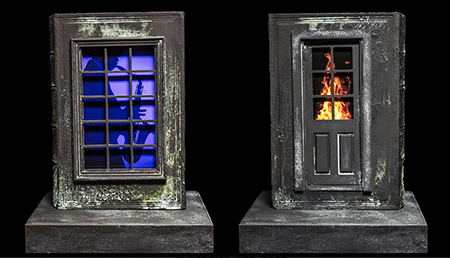
Continuing through October 8, 2023
The current version of the Bellevue Arts Museum is akin to a European Künsthalle: no resident curator, mostly touring exhibitions, and aggressive community outreach events. This works to the advantage of Preston Wadley, until recently a professor of art and photography at Cornish College of the Arts in Seattle. Wadley selected and designed the layout of this show, presenting three important bodies of his work, all photo-based and shot over the past 20 years. It turns out to be deeply moving imagery that conveys a history of African Americans. Starting out with straight black-and-white photography of youth boxing matches nearly 40 years ago (not on view), Wadley progressed to multi-media sculptures integrating vintage photos and daguerreotypes with cast-bronze open-book formats. Each encased photograph is complemented by a sculptural image on the other “page.”
In the “Abstract Truth” series Wadley creates his own genealogy of forgotten and unknown people, sometimes isolated as individuals, other times clustered into group portraits or couples. The results are mysterious and ambiguous, beautiful and entrancing. If you wish to be told the ramifications of an image’s meaning, get hold of the book.
Elsewhere, double-sided works sit on pedestals with comparably ambiguous connections. A third body of work consists of frontal black-and-white portraits of homeless youth. Together, they comprise a humanistic approach to African American life of the past and present which is also inclusive of Native Americans and Asian-Americans.
Just as Jacob Lawrence (with whom Wadley studied at the University of Washington School of Art) expanded his vision to include other people of color once he moved to Seattle in 1970, so Wadley broadened his purview of Seattle citizenry. For example, “The Demos Project,” brings the traditional black-and-white portraits into the present. Each sitter wears a hoodie jacket. Wadley addresses teenagers and adults. And race. While “Reyn” (2010) and “Sean” (2018) are clearly Caucasian, by contrast, “Cam” (2022) is Japanese and “Teo” (2014) is Native American.
Wadley’s background elements are varied, typically reading as urban settings conveyed by what that background is made of. Brick walls, chain-link fences, concrete walls, and ivy-covered buildings, things like that. Each sitter gazes directly at the photographer. In “Chloe” (2022), a young Black girl with a nose ring and dyed-blonde hair curls evinces efforts at self-creation, like many adolescents, regardless of pressures to conform to dress codes and hair styles. Also among the African Americans, “Jules” (2018) and “Clayton” (2016) have vulnerable, querulous expressions that are not stereotypical.
The two-sided pedestal sculptures with which Wadley rounds out the exhibition, each with a window or door to peek through, recall the micro-sculptures of surrealistic bent by H. Ramsay, a prominent Seattle artist in the 1980s. Wadley’s juxtapositions are much more intense and vivid, however, less magical than Ramsay’s but no less ambiguous. “Our Town: Blue Logic” (2022) pairs a blue silhouette of a Black saxophone player on one side with a burning house behind a glass-fronted door on the other. In “The Cycle” (2022), violence against women is explicit with a green-silhouetted couple visible through window panes, the woman fending off the much taller man. Darkest of all, “Mayday” (2022) sets one seated man against another (they could be the same person) holding a gun to his head. In Wadley’s hands, reams of editorials are compressed into single and double images.
The “Abstract Truth” series (2005-2022) is an achievement of note. Taken together, the images have the scope of an historical novel or the TV miniseries “Roots” (1977), although Wadley focuses more on the plight and pleasures of the 20th century for Blacks. Employing what he calls “a semiotic exercise,” the artist uses straightforward images as “signifiers” and oblique, complementary images as the “signified,” or directions to pursue. Among the earliest, such as the very first, “Times Being What They Are” (2005) (drawn from King County police archives), a young man in a mug shot is seen beside an empty window (or jail cell) awaiting him.
As the series progressed, vintage photos of other minorities were included, as in “Chinese Math” (2007), with a photo of coolie field workers presented next to an abacus. In “Aquitania” (2007), a fragment of the Statue of Liberty emerges from the page facing a photo of an ocean liner that brought immigrants from Europe to Ellis Island. A studio photo of two well-dressed Black men in “And Then. And Then.” (2008) depicts a same-sex couple if you also consider the fishhook filling the opposing page. In Wadley’s sole nod to the now-ubiquitous Afro-Futurism movement, “The Poet and the Scribe” (2022) pits a staged scene of be-turbaned Arabs against a tiny replica of a battered Star Wars spaceship. Wadley suggests here that delving into the past is as fruitful as projecting onto an uncertain future.
